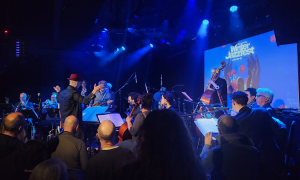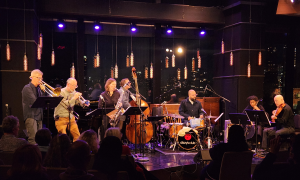Home » Jazz Articles » Live Review » April Jazz 2015
April Jazz 2015

National Concert Hall
Dublin
April 10-12, 2015
April Jazz is the latest addition to Dublin's thriving jazz/improvised music scene. The weekend festival is part of the National Concert Hall's Perspectives program, a series of monthly concerts that spans modern bluegrass and fiddle soundscapes, alt country and contemporary piano recitals. Even within the three-day April Jazz festival there was a little of something for everyone, reflecting the eclectic nature of music that falls under the unwieldy, multi-colored umbrella of jazz.
Day One
Reijseger/Fraanje/Sylla
"It's all coming together these days, isn't it?" remarked violoncellist Ernst Reijseger rhetorically, prior to the opening concert, on the subject of vanishing musical borders. Certainly the trio of Reijeseger, pianist Harmen Fraanje and vocalist percussionist Mola Sylla fuse world, classical and jazz better than most, as demonstrated on Down Deep (Winter and Winter, 2013) and Count to Zen (Winter and Winter, 2014), two of the most beautiful collections of tunes in recent years.
The bulk of the trio's set came from its second CD. Sylla's infectious ostinatos on thumb piano ("Perhaps") and the four- stringed salam ("Bokou") formed the rhythmic pulses, with Reijseger and Frannje weaving independent, yet interconnected lines that waxed and waned. Sylla's husky blues-inflected tenor and percussive accents seduced with a story teller's craft. On "Badola" barking punctuated his plaintive narrative, bird calls were conjured on the haunting ballad "Faleme," while shamanistic chanting colored "Headstream."
Reisjeger drew his own percussive colors from the violincello's body, wetting his finger and drawing cuica cries, or rapping the body in a cajon-like duet with Sylla. Little pegs altered the strings' tonality in one of the more abstract passages while his slap technique bristled with funk energy. Both Reisjeger and Sylla exhibited breathtaking virtuosity throughout the eighty-minute set, yet this was, above all, a most lyrical trio dialog.
The hushed, neo-classical ambiance of "Friuli," with Syllas' whispered vocals adding a ghostly vein to Reijeseger and Fraanje's close-knit lyricism closed the set. The inevitable encores served up the achingly pretty "m'br," built on a Phillip Glass-esque piano motif and swirling arco lines, followed by a danceable West African anthem. It was a suitably stirring finale to an uplifting concert where folkloric, classical, jazz and experimental elements meshed beautifully as one.
Sue Rynhart Duo
On the face of it, vocalist Sue Rynhart's music was a million miles away from Reijseger, Fraanje & Sylla's hybrid musical language. Yet, her intimate duets with double bassist Dan Bodwell likewise drew from disparate roots of jazz, classical, Irish folk, and art-pop.
Against the starry-curtained backdrop of the main stage of the National Concert Hall, Rynhart and Bodwell interpreted faithfully, and with plenty of passion, the songs from Rynhart's striking debut CD Crossings (Self Produced, 2014). However, it was with a new song, "Be Content" that the duo kicked off; Bodwell's grooving bass and Rynhart's uniquely dark-hued yet breezy delivery set the tone for a short, yet captivating set.
Fog-horn arco buoyed Ryhnart's lilting delivery on the sombre poetry of "Wine Dark Sea." On "Wait and See," "She Has Music" and "When You Get Home" the music veered between ethereal folk and gothic pop. Another new tune, "Foxed," ventured into the folk-rock of Sandy Denny-era Fairport Convention, though Rynhart's improvisational flair sets her apart from that tradition. Another burning Bodwell groove introduced "Somewhere to Go," a quirky Rynhart tune that quickly burrowed its way into the sub-conscious.
It's conceivable that Rynhart could add instrumentation to her musical palette but the bare bones pairing of voice and double bass suits Rynhart's poetic vignettes. Sheila Jordan, who practically invented the voice and double bass setting, has refined the art for over fifty years; Rynhart and Bodwell could well do the same with their very personal idiom.
Tomasz Stanko Quartet
Any Tomasz Stańko concert is something of a special occasion. The seventy-two-year-old Polish trumpeter is often referred to as a doyen of European jazz, or some such term, but such geographical definitions ignore his importance on the world stage for over five decades. It was also a rare chance to see Stanko's much vaunted early/mid 2000s quartet, restricted to just occasional performances since the trumpeter formed his New York Quartet at the end of the last decade.
Marcin Wasilewski, Slawomir Kurkiewicz and Michal Miskiewicz have of course flourished prior to and post-Stanko on their own terms but there was always a little magic in this Stanko quartet and from the opening notes of the grooving "Little Thing Jesus," with all four musicians stretching out, it was as if the quartet had never been apart.
The set balanced blue-toned balladry and fiery bop- inspired numbers that covered a fairly expansive arc of Stanko's long career. Stanko remains the ultimate balladeer and scintillating slower numbers peppered the set. Stanko exuded melancholic lyricism on the all too brief "Pearl" and noirish reverie on "Celina" and "Song for Sarah." Greater warmth infused an uplifting rendition of the lovely "Sweet Thing," one of the only tracks from the quartet's three CDs.
Hypnotic at slow tempos, the quartet's heightened interplay was at its most compelling at mid-tempo strolls—such as with the swinging "Elegant Piece"—and on livelier fare. Kurkiewicz and Miskiewicz's incendiary rhythms inspired Wasilewski and Stanko to some thrilling improvisations on "Bosonossa," the bop-fuelled "Gonja" and the bluesy fire of "Celina."
Stanko's quartet was given a standing ovation, returning for a brief encore with a smouldering version of Krzysztof Komeda's "Sleep Safe and Warm." It's a tune Stanko's sidemen recorded on their trio debut, Komeda (GOVI, 1995) and Stanko himself on Litania: Music of Krzysztof Komeda (ECM, 1997), underlining the common DNA that lies at the root of this exceptional quartet.
Beyond the three CDs they recorded together Stanko clearly feels he can delve into his back catalogue with this highly flexible quartet. It's tempting to think they might still return to the studio, nine years after Lontano (ECM, 2006), because it feels like they still have a lot to say to each other.
Day Two
13 Vices
The pairing of Belfast's first Music Laureate, composer Brian Irvine with improvising vocalist Jennifer Walshe on 13 Vices got day two of April Jazz off to a riotous, madly entertaining start. The music for string players and improvising musicians was loosely inspired by Mihail Chemiakin's slightly grotesque sculptures in Moscow, each of which represents a particular adult vice that is damaging to children.
The vices that Chemiakin based his thirteen figures on include alcoholism, prostitution, theft, ignorance, war propaganda, child labour, irresponsible science, indifference and poverty. Irvine and Walshe—though touching on some of Chemiakin's themes— were more concerned with vice in general. As intense as the seventy- five-minute performance was, there was plenty of hilarious satire and dark comedy from the hugely impressive Walshe, who barely drew breath during an exhilarating performance.
With Irvine energetically conducting the Red Note String Ensemble of cellist Robert Irvine, violinist Jackie Shave and violaist Max Baillie, Walshe alternated between improvised vocals—a stream of non-syllabic noises, German song etc—and reading selected texts. It was a full twenty minutes before saxophonist Paul Dunmall, bassist Paul Rogers—both frequent collaborators with Irvine—and percussionist Mark Saunders entered the fray, ratcheting up the intensity to a cacophonous level.
Visceral and abstract, ear-splitting, serene and melodic in turn, Walshe was at the epicentre of the sonic storm as it swelled and diminished. Her tireless improvised meditations on indifference and ignorance, jealousy, beauty/vanity, the manipulation of information/propaganda, fidelity, and sexual abuse/harassment were darkly humorous; the Virgin Mary, Norwegian pop group A-ha, Molly Malone and a brilliant caricature of a drunk on a bus were all press- ganged into the act. "The Fields of Athenry," the classic Irish song of love, oppression and rebellion—and the Irish rugby terrace anthem—will never sound the same again.
Artists like Irvine and Walshe almost never get invited to perform the national anthem before big sports events but life would be far more entertaining if they were allowed a little carte blanche. Energetic and energizing, the musically adventurous, tempestuous fiesta that was 13 Vices proved that entertainment and intellectual stimulation are not incompatible. Sometimes they go hand in hand in wholly unexpected guises.
Sean Mac Erlaine
It's not every day that someone pulls a chalumeau—the baroque precursor of the clarinet—out of their pocket, but Sean Mac Erlaine is no run-of-the-mill musician. The multi- woodwind instrumentalist straddles jazz, folk and free improvisation and is a member of This is How We Fly, which fuses Irish, Swedish and American folk traditions.
His own recordings as leader, Long after the Music is Gone (Ergodos Records, 2012)—haunting meditations inspired by the Irish landscape—and A Slender Song (Ergodos Records, 2014)—a collection of live reed/electronic improvisations—provided the rough blueprint for his quietly captivating thirty-minute set.
On chalumeau and then clarinet Mac Erlaine improvised spare narratives that were ethereal, ghostly and essentially lyrical. Electronic processing created depth of sound and dreamy echo effects. Mac Erlaine drew faintly from Irish traditional language on the original numbers "Kilkenny Dig Out" and "A Curl in The Bonnet," and switching to bass clarinet for the final exploration, used short vocalisations as sounding boards for subtle harmonic improvisations.
The real trick would have been to conjure the bass clarinet from his pocket, but there was still a little magic in Mac Erlaine's unique sound world.
Anouar Brahem
With Ireland gearing up for the centenary celebrations commemorating the 1916 Rising, the Anouar Brahem Quartet's performance marked a rising of more recent vintage. Souvenance (ECM, 2015), the Tunisian oudist's first recording since The Astounding Eyes of Rita (ECM, 2009) was inspired by the so- called Jasmine Revolution of 2010, and his quartet's recital was largely faithful to the soft contours of the recording.
The absence of the Orchestra della Svizzera Italiana—the 18-piece string ensemble that graces the CD—may have stripped the music of its gentle orchestral ambiance, but instead put in relief the intimacy of the quartet dialog. Pianist Francois Couturier's repetitive piano motifs and bassist Björn Meyer's occasionally striking ostinatos created rhythmic ripples in an otherwise serene suite.
Brahem and Couturier were often closely intertwined, like the billowing smoke and dust of the striking—and atypical—cover of the ECM CD. Klaus Gesing on bass clarinet was, for the most part a subtle presence, whose deft interventions were more felt than heard. Improvised and composed lines in this extended tone poem were hazy and it wasn't until the seventy five-minute mark that Couturier unleashed the first unequivocal solo that followed no obvious script.
There was no doubting the poetry of Brahem's music or the hushed intensity of the quartet's delivery but with Souvenance's unfolding dramaturgy built on very subtle shifts in dynamics the emotional impact was equally subtle, and in short, the ninety minutes seemed long. Perhaps in fairness, the narcotic effect of the music was down to the jarring contrast of the highly visceral, adrenaline-fuelled performance of Thirteen Vices that had preceded it. The instant, enthusiastic standing ovation that greeted the musicians was undoubtedly the most fitting comment on Brahem's music.
Day Three
Max Andrzejewski's Hütte with Silver Kites
Since releasing it debut album Max Andrzejewski's Hütte (C-Avi, 2012), the German four-piece has gone from strength to strength. The band won the Neuer Deutscher Jazzpreis 2013, with drummer Andrzejewski wining best soloist.
There have been invites to Havana Jazz in Cuba, tours throughout Germany and Europe and a second album, Hütte und Chor (Traumton Records, 2014). This second album mixed contemporary choral arrangements with Hütte's high energy, electro- acoustic jazz and provided the blueprint for this gig.
Andreas Lang's pronounced bass lines and Andrzejewski's crisp, inventive rhythms underpinned the dual front-line of guitarist Tobias Hoffman and tenor saxophonist Johannes Schleiermacher. "First of May" announced the quartet's credentials, the music moving between walking bass tradition, blustery saxophone and biting, angular guitar solos. "Austria Nervous" shifted tempos between a sultry blues shuffle bordering on the abstract and loose-limbed free-jazz with the impressive Hoffman to the fore. At times the music evoked a gritty cross between Ornette Coleman and Bill Frisell's sound worlds.
On several tracks the quartet was joined by Silver Kites, an experimental Dublin vocal group that has worked on projects as diverse as dance, multi-media exhibitions and Samuel Becket prose. The four members—Lenka Pinterova, Fionnuala Conway, Sharon Phelan and Niall Smith—brought contrastingly smooth textures to Hütte's raucous, hill-billy stomp "Country Girl," rising-falling waves and staccato sequences to the wild, strikingly original "On the Platform" and harmonic buoyancy to the mid-tempo burner "Gospel."
With the collaborative material exhausted, the encore fell to Max Andrzejewski's Hütte -a lyrical ambient piece of minimal gestures. The final bows, however, were rightly enough by all eight musicians, who received sustained applause for a vibrant, soulful and adventurous collaboration.
OKO
As demonstrated on its excellent debut I Love You Computer Mountain (Diatribe Recordings, 2014) Dublin four-piece OKO's hybrid electro- acoustic jazz is very much of the twenty first century. This is a band, however, best appreciated in the live arena.
In a short but powerful set, keyboardist Darragh O'Kelly, guitarist/electronics musician Shane Latimer, drummer Shane O'Donovan and turntable DJ/sampler DJaculate wove a darkly brooding narrative that engaged on multiple levels.
Like any good storyteller, OKO's undulating rhythms and edgy experimentalism hooked from the opening notes. Eschewing the individual excesses of jazz-fusion, an ever-present sense of collective adventure nevertheless underpinned melodic and rhythmic currents that touched on jazz, electronica, dub and ambient sound waves.
A slurred recorded voice provided the intro to the final number, a journey through dreamy psychedelia and minimalism towards denser, more urgent terrain. It was an impressive show and one that underlined OKO's credentials as a boldly experimental group forging a unique identity.
The Bad Plus
The Bad Plus's homage to Ornette Coleman, or more specifically his album Science Fiction (Columbia, 1972) closed April Jazz on a triumphant, celebratory note.
Guest musicans Tim Berne, Ron Miles and Sam Newsome formed a formidable front-line whose arresting harmonics, dissonances, and blistering unison lines, set the bar high from the opening "Civilization Day." There was plenty of individual brilliance in a seventy-minute set (twice as long as the Coleman recording) but it was the collective brio that won the day.
Reid Anderson, David King and Ethan Iverson provided furious rhythmic impulse during the wilder horn passages but what emerged over the course of the performance was a reminder of the rich diversity of Coleman's first recording for Columbia. Gospel tenderness was juxtaposed against tempestuous free improvisation; abstract, Sun Ra-esque meditations were countered by tender and searing blues; straight ahead/bop grooves rubbed shoulders with electronic-rock grooves. It was a gloriously meaty stew, with Anderson even taking Asha Puthli's vocal role on a heartfelt rendition of the epic ballad "All My Life."
At the end, an instantaneous standing ovation greeted the musicians, who encored with a blistering version of "The Jungle is a Skyscraper."
The Bad Plus' homage to Coleman's Science Fiction was faithful to the spirit of the recording without being overly reverential. But in embracing the wild inventiveness and in celebrating the beauty of Coleman's opus The Bad Plus has put a welcome spotlight on one of the landmark early 1970s jazz recordings.
Wrap-up
April Jazz was a resounding musical success. The main hall of the National Concert Hall, however, was less than full for the showpiece concerts, which suggests either that this sort of music remains a hard sell or that a revised marketing campaign may be necessary for future editions. That said, the National Concert Hall and Note Productions deserve plaudits for their initiative and, it is to be hoped, more of a leg-up from local and national press to promote such world class programming.
Photo Credit: Courtesy of Geert Vandepoele
Tags
tomasz stanko
Live Reviews
Ian Patterson
Ireland
Dublin
Ernst Reijseger
Harmen Fraanje
sue rynhart
Dan Bodwell
Sheila Jordan
Marcin Wasilewski
Slawomir Kurkiewicz
Michal Miskiewicz
Paul Dunmall
Paul Rogers
Sean Mac Erlaine
Anouar Brahem
Francois Couturier
Björn Meyer
Klaus Gesing
Ornette Coleman
Bill Frisell
The Bad Plus
Ornette Coleman
Tim Berne
Ron Miles
Sam Newsome
Reid Anderson
David King
Ethan Iverson
Sun Ra
PREVIOUS / NEXT
Support All About Jazz
 All About Jazz has been a pillar of jazz since 1995, championing it as an art form and, more importantly, supporting the musicians who make it. Our enduring commitment has made "AAJ" one of the most culturally important websites of its kind, read by hundreds of thousands of fans, musicians and industry figures every month.
All About Jazz has been a pillar of jazz since 1995, championing it as an art form and, more importantly, supporting the musicians who make it. Our enduring commitment has made "AAJ" one of the most culturally important websites of its kind, read by hundreds of thousands of fans, musicians and industry figures every month.



























